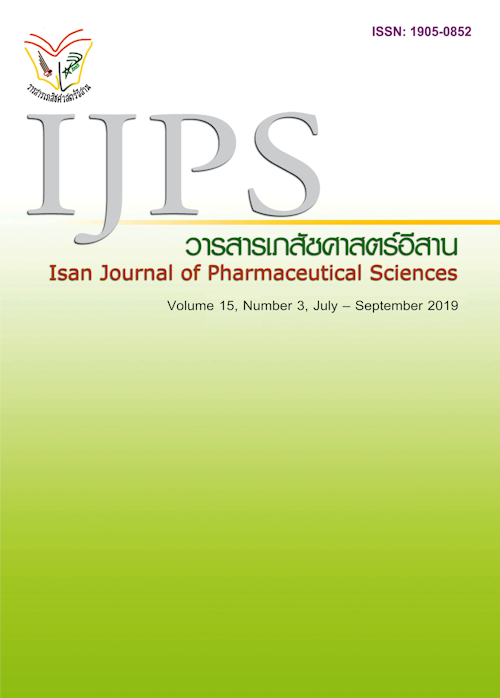การลดการติดคราบจุลินทรีย์ของน้ำยาบ้วนปากใบฝรั่งในผู้ป่วยเบาหวาน
Main Article Content
บทคัดย่อ
สมุนไพรใบฝรั่งเป็นสมุนไพรพื้นบ้านที่มีคุณสมบัติและสรรพคุณในเรื่องของการลดการติดคราบจุลินทรีย์ได้ วัตถุประสงค์งานวิจัยในครั้งนี้เพื่อศึกษาประสิทธิผลของน้ำยาอมบ้วนปากใบฝรั่งต่อการลดการติดคราบจุลินทรีย์เปรียบเทียบผลกับน้ำยาอมบ้วนปากผสมคลอเฮกซิดีนในผู้ป่วยเบาหวานที่มารับบริการที่โรงพยาบาลพุทธชินราช พิษณุโลกอำเภอเมืองจังหวัดพิษณุโลก วิธีดำเนินการศึกษา: ทำการแบ่งกลุ่มอาสาสมัครผู้ป่วยเบาหวานจำนวน 30 รายออกเป็น 2 กลุ่มคือกลุ่มที่ใช้น้ำยาบ้วนปากใบฝรั่งจำนวน 15 รายและกลุ่มที่ใช้น้ำยาบ้วนปากผสมคอลเฮกซิดีนจำนวน 15 รายโดยให้อาสาสมัครอมน้ำยาบ้วนปากตามชนิดของกลุ่มทดลองด้วยปริมาณน้ำยาบ้วนปาก 30 ซีซี ต่อครั้งหลังการแปรงฟัน 3 เวลา นานครั้งละ 2 นาทีทุกวันเป็นเวลา 1 เดือน ผลการศึกษา: ก่อนใช้ค่าเฉลี่ยดัชนีการติดคราบจุลินทรีย์ระหว่างกลุ่มผู้ใช้น้ำยาอมบ้วนปากใบฝรั่งกับกลุ่มผู้ใช้น้ำยาอมบ้วนปากผสมคลอเฮกซิดีนมีค่าเฉลี่ยที่ 2.60±0.51และ 2.73±0.46 โดยไม่แตกต่างกันอย่างมีนัยสำคัญทางสถิติ (p=0.414) ค่าเฉลี่ยดัชนีการติดคราบจุลินทรีย์กลุ่มผู้ใช้น้ำยาอมบ้วนปากใบฝรั่งและกลุ่มผู้ใช้น้ำยาอมบ้วนปากผสมคลอเฮกซิดีนก่อนใช้กับหลังใช้ในสัปดาห์ที่ 4 มีค่าลดลงที่ 0.60±0.10 และ 0.64± 0.08 ตามลำดับ โดยมีความแตกต่างกันอย่างมีนัยสำคัญทางสถิติที่ p<0.05 และค่าเฉลี่ยดัชนีการติดคราบจุลินทรีย์ระหว่างกลุ่มผู้ใช้น้ำยาอมบ้วนปากใบฝรั่งกับกลุ่มผู้ใช้น้ำยาอมบ้วนปากผสมคลอเฮกซิดีนภายหลังการทดลองในการลดติดคราบจุลินทรีย์ได้ไม่แตกต่างกันอย่างมีนัยสำคัญทางสถิติที่ p=0.221 สรุปผล: น้ำยาอมบ้วนปากทั้งสองชนิดสามารถลดการติดของคราบจุลินทรีย์ในช่องปากของผู้ป่วยเบาหวานได้ไม่แตกต่างกันโดยน้ำยาบ้วนปากจากใบฝรั่งสามารถใช้เป็นน้ำยาบ้วนปากทางเลือกในการลดคราบจุลินทรีย์ในช่องปากได้
Article Details
กรณีที่ใช้บางส่วนจากผลงานของผู้อื่น ผู้นิพนธ์ต้อง ยืนยันว่าได้รับการอนุญาต (permission) ให้ใช้ผลงานบางส่วนจากผู้นิพนธ์ต้นฉบับ (Original author) เรียบร้อยแล้ว และต้องแนบเอกสารหลักฐาน ว่าได้รับการอนุญาต (permission) ประกอบมาด้วย
References
Ainamo, J., Bay, I., 1975. Problems and proposals for recording gingivitis and plaque. Int Dent J 25, 229-235.
Arunachalam, L.T., Sudhakar, U., Vasanth, J., Khumukchum, S., Selvam, V.V., 2017. Comparison of anti-plaque and anti-gingivitis effect of curcumin and chlorhexidine mouth rinse in the treatment of gingivitis: A clinical and biochemical study. Journal of Indian Society of Periodontology 21, 478-483.
Chouhan, S., Sharma, K., Guleria, S., 2017. Antimicrobial Activity of Some Essential Oils—Present Status and Future Perspectives. Medicines 4, 58.
Dutta, S., Das, S., 2010. A study of the anti-inflammatory effect of the leaves of Psidium guajava Linn. on experimental animal models. Pharmacognosy Res 2, 313-317.
Girgune, J., Jain, N., Garg, B., 1978. Antibacterial activity of some essential oils. Current Science 47, 454-455.
Gordon, M.H., 1996. Dietary antioxidants in disease prevention. Natural Product Reports 13, 265-273.
Juntavee, A., Peerapattana, J., Ratanathongkam, A., Nualkaew, N., Chatchiwiwattana, S., Treesuwan, P., 2014. The antibacterial effects of apacaries gel on Streptococcus mutans: An in vitro study. International journal of clinical pediatric dentistry 7, 77.
Lee, W.C., Mahmud, R., Pillai, S., Perumal, S., Ismail, S., 2012. Antioxidant activities of essential oil of Psidium guajava L. leaves. APCBEE Procedia 2, 86-91.
Lutterodt, G.D., 1992. Inhibition of Microlax-induced experimental diarrhoea with narcotic-like extracts of Psidium guajava leaf in rats. J Ethnopharmacol 37, 151-157.
Nagasri, M., Madhulatha, M., Musalaiah, S.V.V.S., Kumar, P.A., Krishna, C.H.M., Kumar, P.M., 2015. Efficacy of curcumin as an adjunct to scaling and root planning in chronic periodontitis patients: A clinical and microbiological study. Journal of Pharmacy & Bioallied Sciences 7, S554-S558.
Prabu, G.R., Gnanamani, A., Sadulla, S., 2006. Guaijaverin – a plant flavonoid as potential antiplaque agent against Streptococcus mutans. Journal of Applied Microbiology 101, 487-495.
Qadan, F., Thewaini, A.J., Ali, D.A., Afifi, R., Elkhawad, A., Matalka, K.Z., 2005. The antimicrobial activities of Psidium guajava and Juglans regia leaf extracts to acne-developing organisms. Am J Chin Med 33, 197-204.
Rees, T.D., 1994. The diabetic dental patient. Dental Clinics of North America 38, 447-463.
Sarin, S., Marya, C., Nagpal, R., Oberoi, S.S., Rekhi, A., 2015. Preliminary Clinical Evidence of the Antiplaque, Antigingivitis Efficacy of a Mouthwash Containing 2% Green Tea - A Randomised Clinical Trial. Oral Health Prev Dent 13, 197-203.
Sawang-ar-rom W, C.P., 2012. Comparison of the effects of herbal extracts.To inhibit the bacteria. Science and Technology 12.
SG, C., 2000. Antiseptics and antibiotics as chemotherapeutic agents for periodontitis management. Compend Contin Educ Dent 21, 59-62.
Samranrit K, Chu S, Development of Guava Leaf Extract Chewable Tablets Against Streptococcus mutans Emerg Infect Dis [serial online] 2008 Jun, [cited 2018 Jun 13; 1(1): [5 screens]. Available from: https://www.pharmacy.mahidol.ac.th
Ship, J.A., 2003. Diabetes and oral health: An overview. The Journal of the American Dental Association 134, 4S-10S.
Taweechaisupapong, S., Wongkham, S., Chareonsuk, S., Suparee, S., Srilalai, P., Chaiyarak, S., 2000. Selective activity of Streblus asper on Mutans streptococci. Journal of Ethnopharmacology 70, 73-79.

